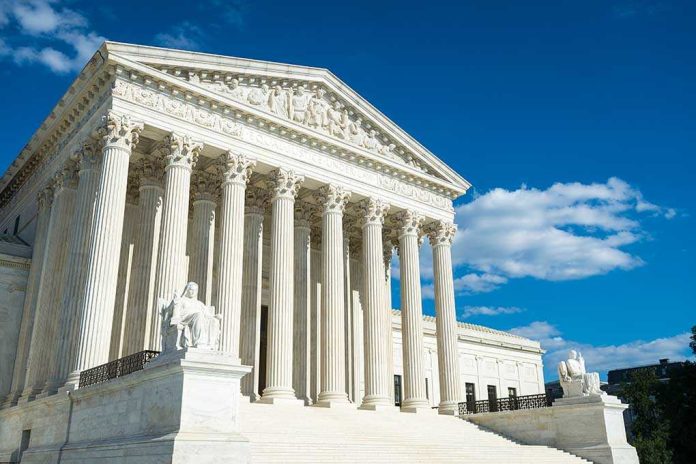
Bayer’s $11 billion liability nightmare from Roundup cancer lawsuits faces a turning point as the Supreme Court seeks federal guidance, potentially saving the company billions if federal pesticide laws trump state safety regulations.
Key Takeaways
- The Supreme Court has invited the Department of Justice to provide input on Bayer’s appeal regarding Roundup cancer lawsuits, potentially affecting thousands of pending cases
- Bayer has already agreed to pay nearly $11 billion to settle most Roundup cancer claims, but faces 4,424 additional cases in federal court
- The International Agency for Research on Cancer classified glyphosate, Roundup’s active ingredient, as a “probable carcinogen” in humans
- The central legal question is whether federal pesticide regulations (FIFRA) preempt state-level failure-to-warn lawsuits
- Lower courts remain divided on the issue, with the 3rd Circuit siding with Bayer while the 9th and 11th Circuits ruled for plaintiffs
Supreme Court Intervention in Roundup Litigation
The Supreme Court has taken a significant step in the ongoing Roundup litigation by requesting input from the Department of Justice, a move that could potentially save Bayer billions in liability claims. Since acquiring Monsanto in 2018, Bayer has been fighting an uphill battle against thousands of lawsuits claiming that the popular weedkiller causes non-Hodgkin lymphoma. The company’s legal strategy now hinges on convincing the Supreme Court that federal pesticide regulations should shield it from state-level failure-to-warn claims, a position that would effectively end much of the pending litigation.
The request for the Solicitor General’s views signals the Court’s interest in resolving conflicting lower court rulings on whether the Federal Insecticide, Fungicide and Rodenticide Act (FIFRA) preempts state law claims. This legal question is critical because FIFRA restricts states from imposing labeling requirements beyond federal standards. If the Court ultimately sides with Bayer, it could establish a precedent protecting manufacturers from liability when their products meet federal regulatory standards, regardless of potential health risks identified after approval.
Cancer Claims and Scientific Controversy
The scientific debate surrounding Roundup’s safety remains contentious despite Bayer’s insistence that the product poses no cancer risk. Critics point to the International Agency for Research on Cancer’s classification of glyphosate as evidence of danger. “The International Agency for Research on Cancer classified the active ingredient that most Roundup formulas used to have, glyphosate, as a ‘probable carcinogen’ in humans,” according to information from Drugwatch, a consumer advocacy organization. This classification has been a cornerstone of plaintiffs’ arguments in the thousands of lawsuits filed against the company.
“Roundup lawsuits filed against Monsanto (now Bayer) claim the weed killer caused cancer, and the company failed to warn about the health risks of glyphosate,” shared Drugwatch.
Despite these concerns, Bayer maintains that regulatory agencies worldwide, including the U.S. Environmental Protection Agency, have consistently determined that glyphosate-based products can be safely used according to label directions. The company has taken some responsive measures, however, discontinuing residential formulas containing glyphosate in 2023 while continuing to assert the product’s safety. This contradiction between regulatory findings and independent research has created a perfect storm of legal uncertainty that the Supreme Court may soon address.
Financial Impact and Legal Strategy
The financial stakes for Bayer cannot be overstated. Having already committed nearly $11 billion to settle existing claims, the company faces thousands more cases that could potentially cost billions in additional liability. As of June 2025, federal courts in California alone are handling 4,424 open Roundup lawsuit cases. Bayer’s executives view the Supreme Court’s request for government input as a positive development that could limit or even eliminate this massive financial exposure if the Court ultimately rules that federal regulations preempt state law claims.
The legal landscape remains divided, with the 9th and 11th Circuit Courts siding with plaintiffs while the 3rd Circuit supported Bayer’s position. This circuit split creates exactly the type of legal uncertainty that often prompts Supreme Court intervention. Bayer has consistently argued that EPA-approved labels should shield the company from state-level failure-to-warn lawsuits. If the Supreme Court agrees, it could fundamentally alter the landscape of product liability litigation in America, potentially limiting the ability of citizens to seek compensation for injuries caused by federally regulated products.
Conservative Implications
For conservative Americans, this case represents a critical test of federalism and regulatory authority. At stake is whether federal agencies should have the final say on product safety, or if state courts can impose additional liability based on failure-to-warn theories. The Biden administration’s Department of Justice will now weigh in on this question, potentially setting up a clash between federal regulatory power and states’ traditional authority over tort law. President Trump’s appointment of conservative justices to the Supreme Court may ultimately benefit Bayer’s position, as these justices have generally favored federal preemption in similar contexts.
While the timing remains uncertain, Bayer hopes for a Supreme Court decision within a year. The outcome will not only determine the fate of billions in potential liability for one company but could reshape the entire landscape of product liability litigation in America. If federal regulation is deemed to preempt state-level claims, manufacturers of everything from pharmaceuticals to chemicals could gain significant protection from lawsuits, fundamentally altering the balance between corporate accountability and regulatory compliance in ways that will impact American consumers for generations.









